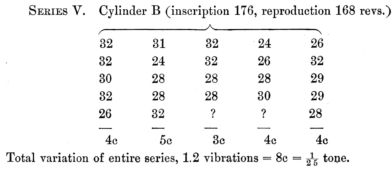Traditional Hopi Songs - online book
Native American Songs With Sheet Music, Notation & Commentary
| Share page | Visit Us On FB |
|
42 HOPI SONGS
Taking up the tests again three days later, I took an inscription of the harmonium c' on Cylinder F, the rate of revolution being made 192 per minute for comparison with E at 184. F proved practically worthless, the tone being irregular throughout and changing toward the end through a whole minor third. From this whole series of tests of rapidity I concluded that the limits beyond which the performance of the instrument would begin to show marked deterioration might be set at 155 and 180 revolutions per minute.
Cylinder B (176, 170 + ) had then been taken, and was used in my tests at very nearly the most favorable possible rapidity. To finish these tests of the phonograph by the method of beats, I made one more series (quintuple) with B, obtaining the following figures: — |
||
 |
||
|
The individual variations averaged even less than any yet noted ; and the total variation during a performance of about twelve minutes was exactly what it had been in three out of the four previous series, viz., 8c, or the 25th of a tone. The ephemeral hurrying and slowing of the beats somewhat beyond the limits expressed in the figures also reappeared occasionally. But this series differed from the preceding, in that the progressive sharping had given place to an irregular variation. At the same time I noticed that in the last quarter of the cylinder the element of tone had entirely disappeared in a scraping noise. With this series I ended my tests of the phonograph.
In the earlier reproductions of Cylinder B, if we take  as the initial tone, we have as the initial tone, we have increasing to a maximum of increasing to a maximum of of a tone as we take v farther along in the reproduction. This suggests looking for conditions affecting the rate of the instrument, which progressively change from beginning to end of a cylinder, and which, if present in both inscription and reproduction, are more effective in the one case than in the other. The wax cylinder which is used in the phonograph is carried on one end of a shaft of about two and one half times its length. At the beginning of an inscription the needle is approx- of a tone as we take v farther along in the reproduction. This suggests looking for conditions affecting the rate of the instrument, which progressively change from beginning to end of a cylinder, and which, if present in both inscription and reproduction, are more effective in the one case than in the other. The wax cylinder which is used in the phonograph is carried on one end of a shaft of about two and one half times its length. At the beginning of an inscription the needle is approx- |
||